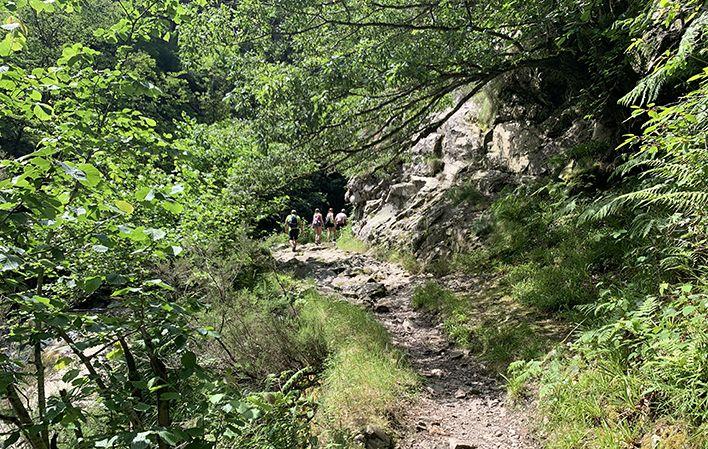
Route of the Dawn
- Address Sobrescobio Asturias Centre
- Distance Distance: 6,2 kms
- Difficulty Difficulty: Short
- Code Code: PR62
- Altitude Altitude: 587 m.
- Unevenness Unevenness: 128 m.
-
On foot
On foot:
2 h. 30 min.
One way
- Start point Start point: Soto (Sobrescobio)
- Route type Route type: hiking
- Tour type Tour type: Round trip
- Layout of the route Layout of the route: Download kml, Download gpx
Info
It is undoubtedly one of the best-known routes in Asturias, and there is no shortage of reasons for this. Declared a Natural Monument, this track, fundamentally a livestock track, although it was also a mining track, is located at the bottom of a valley and runs at all times alongside the river Alba or Llaímo.
The landscape, vegetation and fauna are overwhelming, but above all the fundamental element is water. Water in river rapids, backwaters, pools, streams that cross each other, fountains and troughs, or in trickles that come out of the rock creating travertines.
And perhaps the water gives us one of the most beautiful and striking landscape elements of the route, the waterfalls, especially two that further embellish this already spectacular path. Their limpid waters welcome the blackbird and the kingfisher, and on the slopes of the mountains, which reach the river, we can observe with patience, attention and binoculars the deer that live in them.
Route
Soto - Cruz de los Ríos 3
The route starts in the village of Soto. It is a concrete path for most of the route, except for the last stretch, which is always uphill and heading south. The entrance to the route is well signposted in the village on information posts. We begin by walking along the edge of several farms.
After the first kilometre, we enter the real beginning of the route, where we will find the fish farm on our left; this will be our first contact with the river Alba. After 800 metres, there is a bridge on our left with a sign saying: "Do not stop, one person every 5 metres".
From kilometre 2 onwards, the Alba gorge begins, the valley starts to narrow and the river flows closer to the path. A few metres further on, on the crag that rises up to our right, we can see a rock formation in the shape of a horn, which the locals call "el Vigilante" (the watchman). From here onwards we will be able to see small waterfalls in the river, which will grow as we advance in the opposite direction to its course.
We will have walked about 3.4 kilometres from the start of the route and on our left we will find a picturesque little house, accessed by a wooden bridge, which adds even more charm to the landscape. To the right, the remains of the "El Campurru" loading bay, an old construction reconquered by nature that was part of the infrastructure of the Carmen mine.
Two kilometres further on, there is a rest area on the left-hand side of the path and a fork in the road. Continue along the path on the left, which from here onwards is no longer concreted.
At this point the steepest section of the route begins, where you will find the biggest waterfalls on the route, some of which are up to ten metres high. Be careful in this area, as, although there are some small sections that have been prepared, the ground can be slippery.
At kilometre 6.8, there is a wide bridge that leads to the Cruz de los Ríos, which marks the end of the first part of this route. A few metres further on there is a well-equipped recreational area where you can rest before returning the way you came.
Map
Itinerary
Soto de Agues - Brañas de la Vega - Foces de Llaímo - Pontona - Resquiebra Bridge - Cruz de los Ríos - San Andrés - Soto de Agues



